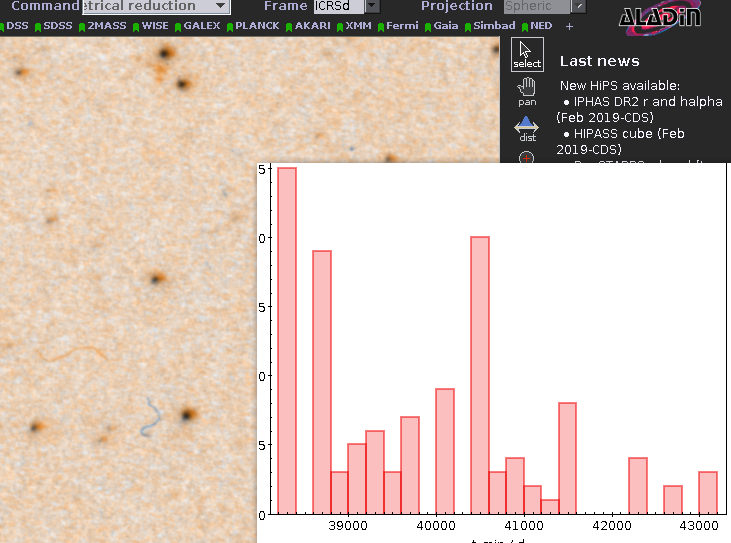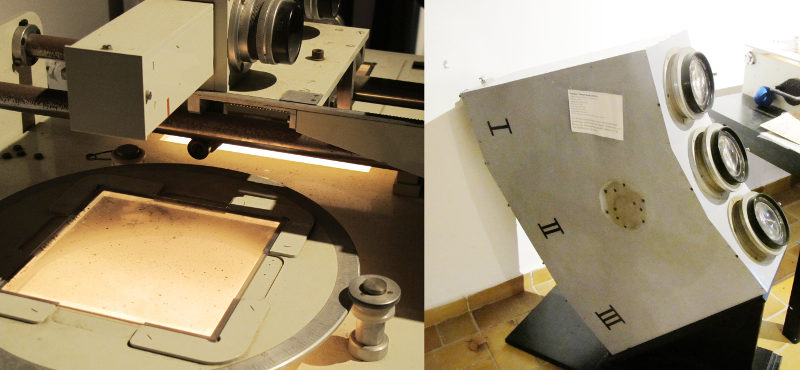APPLAUSE via Obscore

Aladin showing some Bamberg Sky Patrol plates (see towards the end of the post for what this is and how I made it).
At the Astroplate conference I blogged about recently, the people behind APPLAUSE gave a couple of talks about their Data Release 3. APPLAUSE is a fairly massive endeavour to make available data from some of the larger plate archives in Germany, and its DR3 even hit the non-Astronomy press last February.
Already for previous APPLAUSE releases, I've wanted to bring this data (or rather, its metadata) to the VO, but it never quite happened, basically because there was always another little thing that turned out to be too tedious to work out via mail. However, working out things interactively is exactly what conferences are great for. So, the kind APPLAUSE folks (thanks, Taavi and Harry) and I used the Astroplate to map their database schema (“schema” is jargon for what boils down to the set of tables and columns with which they describe their data) to the much simpler (and, admittedly, less powerful) IVOA Obscore one.
Sure, Obscore doesn't deal with multiple exposures (like when the target field and the north pole were exposed on one plate to help precision photometry), object-guided images, and all the other interesting techniques that astronomers applied in the pre-digital age; it also doesn't usefully cope with multiple scans of the same plate (for instance, to correct for imprecisions in the mechanics of flatbed scanners). APPLAUSE, of course, has to cope with them, since there are many reasons to preserve data of this kind.
Obscore, on the other hand, is geared towards uniform discovery, where too funky datasets in all likelihood cause more harm than good. So, when we mapped APPLAUSE to Obscore, of the 101138 scans of 70276 plates that the full APPLAUSE holds in DR3, only 44000 plate scans made it into the Obscore table. The advantage: whatever can be sensibly mapped to Obscore can now be queried together with all the other data in the world that others have published through Obscore.
You can immediately see the effect when you run the little python program doing the global discovery we gave in our plates tutorial. Here's what it prints now (values from pre-APPLAUSE-in-Obscore are in square brackets):
Column t_exptime: 3460 values Min 12, Max 15300, Mean 890.24 [previous mean: 370.722] --- Column em_mean: 3801 values Min 1.8081e-09, Max 9.3e-07, Mean 6.40804e-07 [No change: Sigh!] --- Column t_mean: 4731 values Min 12564.5, Max 58126.3, Mean 49897.9 [previous mean: 51909.1] --- Column instrument_name: 4747 values Matches from , Petzval, [Max Wolf's residence in Heidelberg, Maerzgasse, Wolf's Doppelastrograph, Heidelberg Koenigstuhl (24), Wolf's Doppelastrograph,] AG-Astrograph, [Zeiss Triplet 15 cm Potsdam-Telegrafenberg], Zeiss Triplet, Astrograph (four 10-cm Tessar f/6 cameras), [3.5m APO, ROSAT PSPCC, Heidelberg Koenigstuhl (24), Bruce Astrograph, Calar Alto (493), Schmidt], Grosser Refraktor, [ROSAT HRI, DK-1.54], Hamburger Schmidt-Spiegel, [DFOSC_FASU], ESO 1-metre Schmidt telescope, Great Schmidt Camera, Lippert-Astrograph, Ross-B 3", [AZT 22], Astrograph (six 10-cm Tessar f/6 cameras), 1m-Spiegelteleskop, [ROSAT PSPCB], Astrograph (ten 10-cm Tessar f/6 cameras), Zeiss Objective --- Column access_url: 4747 values [4067]
So – for the fields selected in the tutorial, there are 15% more images in the global Obscore image pool now than there were before APPLAUSE, and their mean observation date went a bit farther into the past. I've not made any statistics, but I suspect for many other fields the gain is going to be much higher. For a strong effect, try some random region covered by the Bamberg Sky Patrol on the southern sky.
But you have probably noticed the deep sigh in the annotations to the statistics above: Yes, we don't have the spectral band for the APPLAUSE data, which is why the stats on em_min doesn't change. As a matter of fact, from the Obscore data you can't even guess whether a plate is “more red” or “rather blue”, as Obscore doesn't have an (agreed-upon) field for “qualititive bandpass indicator”.
For some other data collections, we did map known emulsion/filter combinations to rough bandpasses (e.g., the Palomar-Leiden Trojan Survey, which only had a few of them). For APPLAUSE, there are 435 combinations of filter and emulsion (that's a VOTable link that you can paste into TOPCAT's load button in order to have a look at the table). Granted, quite a few of these pairs are (more or less) spurious because of inconsistent spelling. But we still gave up on researching the bandpasses even before we started.
If you're a photographic plate buff: You could help us and posteriority a lot if you could go through this list and at least for some combinations tell us what, roughly, the lower and upper limits of the corresponding bandpasses might have been (what DaCHS already knows, plate-relevant data near the bottom of the file). As usual, send mail to gavo@ari.uni-heidelberg.de if you have anything to contribute.
Finally, here's the brief explanation of the image for this article: Well, I wanted to find some Bamberg Sky Patrol images for a single field to play with. I knew they were primarily located in the South, and were made using Tessar cameras. So, I ran:
SELECT t_min, access_url, s_region FROM ivoa.obscore WHERE instrument_name like '%Tessar%' AND 1=CONTAINS(POINT(345, -38), s_region)
on GAVO's TAP service. Since Aladin 10, you can do that from within the program (although some versions will reject this query because they mistakenly believe the ADQL is bad. Query through TOPCAT and send the result over to Aladin if that bites you). Incidentally, when there are s_region values in Obscore tables, it's a good idea to use them as I do here, as it's quite a bit more likely that this query will use indices than some condition on s_ra and s_dec. But then not all services fill s_region properly, so for all-VO queries you will probably want to make do with s_ra and s_dec.
From that result I first made the inset bar graph in the article image to show the temporal distribution of the Patrol plates. And then I grabbed two (rather randomly selected) plates and had Aladin produce a red-blue composite of them. Whatever is really red or really blue in that image may correspond to a transient event. Or, as certainly the case with that little hair (or whatever) that shines out in blue, it may not.

![[RSS]](./theme/image/rss.png)

![[Screenshot: graphs and numbers]](/media/stats_gregory.png)
